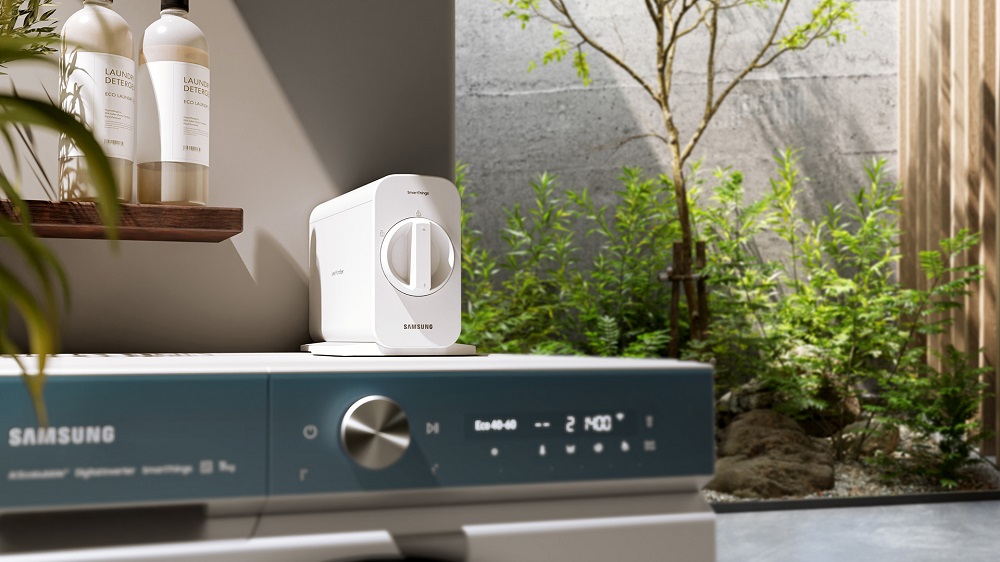Easy to monitor and maintain, the Less Microfiber™ Filter cuts 98% of microplastic emissions from laundry cycles and makes tackling ocean-bound plastics a natural part of daily life
Samsung Electronics today announced the launch of the new Less Microfiber™ Filter, an external washing machine filter designed to significantly reduce plastic microfiber emissions during laundry cycles. Designed with inspiration from apparel maker Patagonia and expertise from the global ocean conservation organization Ocean Wise, the filter builds on the success of last year’s Less Microfiber™ Cycle to substantially cut microplastics and enable sustainable laundry washing that is both effective and effortless. The new filter is now available in Korea and the U.K. and will roll out to other countries in the third quarter.
“With microplastics emissions to our oceans continuing to increase and regulations being strengthened in many countries, as well as microplastics becoming a growing health concern for people everywhere, Samsung worked with Ocean Wise and Patagonia to engineer technology to prevent the release of microplastics from our daily life,” said Moohyung Lee, Executive Vice President and Head of R&D Team of Digital Appliances Business at Samsung Electronics. “With innovations like the Less Microfiber™ Filter and Cycle, Samsung is enabling Everyday Sustainability in a wider array of products and making eco-conscious daily practices second nature in the home.”
From the Less Microfiber™ Cycle to the Less Microfiber™ Filter: Stopping Microplastics Before They Enter the Ocean

To enable customers to cut microplastic emissions from their laundry, Samsung first developed the Less Microfiber™ Cycle, a wash course that reduces microplastic shedding by 54%1 in part by leveraging Samsung’s proprietary Ecobubble™ technology. By using bubbles to help dissolve and absorb detergent, less heat and energy is required to wash clothes, resulting in reduced abrasion which in turn prevents microplastic emissions.
The Less Microfiber™ Filter takes this a step further, preventing up to 98%2 of microplastics released during laundry from escaping into the ocean, equivalent to eight 500ml plastic bottles per year3 when used four times a week. In addition, to help more customers get involved in cutting microplastic emissions, the Less Microfiber™ Filter has a mountable design style that allows it to be used with standard washing machine models, demonstrating the company’s dedication to long-term sustainability and helping customers embrace sustainability at home.
Sustainable Convenience Every Day and at Every Stage of the Product Lifecycle

Samsung is committed to developing new products and technologies for a sustainable future. As we strive to enable Everyday Sustainability, not only should these products be highly effective, they should also be simple, accessible and convenient to use while considering eco-conscious practices in each aspect of product development.
With this in mind, the Less Microfiber™ Filter is made using recycled plastics — to help incorporate sustainability at every stage of its lifecycle – and was designed to be long-lasting and easy to maintain. The filter’s blades capture the microplastics with a 65-70 micrometer wide mesh, then redirect and compress these microplastics to one side, meaning the filter only needs to be cleaned roughly once a month.
By connecting with Samsung’s intelligent connectivity platform SmartThings, the filter tracks how full it is from 0 to 100%, alerting users when cleaning or other troubleshooting is required via the SmartThings app. The Less Microfiber™ Cycle, meanwhile, is available as a preset option on select Samsung washing machines from 2022 and can be activated with just the press of a button. It will be expanded to users of previous Wi-Fi enabled Samsung washing machine models through an over the network update this year.
Innovation for a Brighter Future
The development and launch of the Less Microfiber™ Cycle and Filter are just the latest steps in Samsung’s sustainability journey.
“Samsung Electronics and Patagonia’s efforts to reduce the harmful microplastics emissions being released into our oceans do not end here,” said Vincent Stanley, Director of Philosophy at Patagonia. “We look forward to bringing this collaborative, sustainable spirit to further projects with industry partners to create even more solutions that combat marine pollution.”
Beyond the launch of the Less Microfiber™ Cycle and Filter, Samsung will continue developing new technologies and products that make Everyday Sustainability an effortless part of daily life for customers everywhere and continue to work with partners like Patagonia to deliver tomorrow’s eco-conscious household solutions.
1 Tested with 2kg load of 100% polyester hoodies, comparing Synthetics cycle on Samsung Conventional model WW4000T and the Less Microfiber™ Cycleon WW9400B. The results may be different depending on the clothes and environment. Tested at the Ocean Wise Plastics Lab.
2 Tested at Ocean Wise Plastics Lab on the WW90T734DWH model (using Synthetic cycle, approximately 2kg load of synthetic textile laundry) comparing the amount of microfiber released with and without the Less Microfiber™ Filter installed. The amount is calculated by filtering drain water through a 50um filter. Results may vary depending on clothes and environment.
3 Tested at Ocean Wise Plastics Lab on the WW90T734DWH model (using Synthetic cycle, approximately 2kg load of synthetic textile laundry) comparing the amount of microfiber released with and without the Less Microfiber™ Filter installed. The amount is calculated by filtering drain water through a 50um filter. One wash cycle’s reduction amount of 0.627g is based on a 5kg load (0.125g/kg x 5kg). Annual reduction amount (132g) is calculated based on 210 cycles (4 times a week, 52 weeks) and 5kg load on each cycle. 500㎖ bottle weight (15.4g) is based on the Korea Ministry of Environment’s guideline on plastic bottles.
Source: Samsung Global Newsroom


Comments